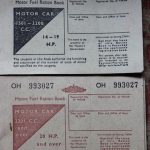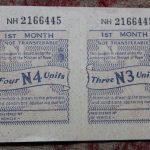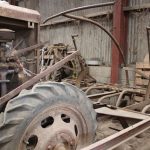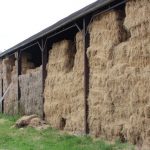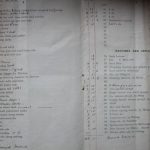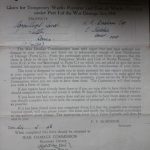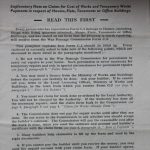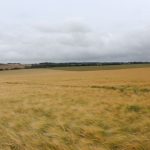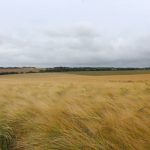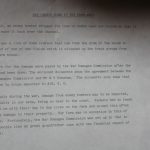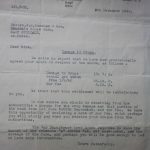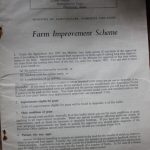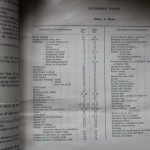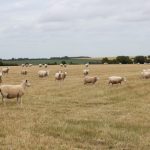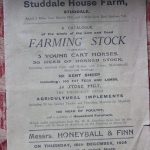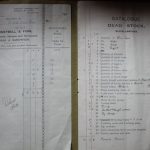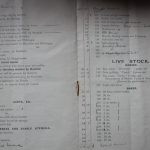
C.W. Densham
About
| Farmer’s name | C.W. Densham |
| Age | – |
| Location | Studdale Farm Denton, East Studdal |
| Size | 290 acres |
| Type | Mixed |
Interviewed by: Louise Rasmussen
Date: 12 July 2015
Transcript
(Mr. Densham hands me a project that his son has written about the farm)
Louise: So a hundred years the family has been here?
CW: Yes, the family, they came from, grandfather came from Devon, and they were farmers in Devon, but he was the youngest son, so he sort of got thrown out and came up. And he was a pharmacist for a while, but he came up here and bought this, and it was not quite as big at the time, and … then my father took over, and then I’ve taken over, and then you saw my son. And he’s around now, so…
… Louise: So it used to be a mixed farm?
CW: Mixed, well, it was well mixed, but we’re not quite so mixed now as I can tell you about what’s changed over the years.
Louise: In what ways would you say it has changed then? Over the years…
CW: No, so anyway, yeah…19… I forgot what it says in here… (looks through his sons project) I think when he first started, it was about … I think it was about 170 acres, when they first bought it. And then we’ve increased the size, not very much, we’re now, we farm about 290 acres. So it’s gone up a bit. But there’s only the two of us do it. And back in time gone by, there used to be 10 cottages, so there were 10 people working here, before the Second World War, in 19… Get your History as well! Back in the 30s and 1940s there were tenants, and then after the War, it dropped down…Well, in 1923, only half the farm–cause there was a Depression–only half the farm was farmed, and it went, it was left for about three years during the Depression. I don’t know whether you know about the Depression in Britain. I think it was the same worldwide. Cause America had the same thing. So only half the farm, but then just before the War, they started doing more, and they had a lot of grassland. And then during the War, they had to plough up, to make more food for Britain, because it was not being imported. So there was quite a bit…In the 1940s and 50s, 1950s it started changing again, it was becoming more mechanical. And about 1960 there were only, well, there was my father and three other people working here. So there was four people. And then it dropped down again, and now there’s only two of us here, but we do have a casual person who lives in one of the cottages, who comes in and sort of drives grain trailers and that sort of thing. So helps out then, so it’s sort of two and a bit, dropping down…But we’re all machinery, everything’s done by machine now. So…we used to…we only do corn, sheep, and grass for hay and, now. But we used to do, we used to have beef, and we used to do winter vegetables: cauliflower, cabbage and that sort of thing. But we stopped doing the beef about 12 years ago when we had, there was a BSC disease, which meant it was hard work moving everything around. Don’t know how much you know about agriculture and stuff? And so we stopped doing beef, we kept, increased the sheep a little bit, and we stopped doing vegetables about three years ago, because they were importing so much, and where we supplied, they used to sell it to the cruise ships and to the ferries, it all used to go there, but then they started wanting it not as whole cauliflowers, they wanted it processed. So that you kept putting into a bag, and of course they only wanted about half the amount then. So we decided we backed out and we… so we now got sheep, cereals and grass. So that’s…and all our corn goes…Well, we have malting barley, you know the one with the horns on. That goes for malting, and the winter wheat all goes for seed, and the spring barley goes for seed, so, cause you get a premium for that, so it’s a …we’re quite, what we call a clean farm, so most of the time, you know, we don’t have wild oats or anything…So we can do it because it…you have to set sort of specifications for seed, and there mustn’t be anything in it that shouldn’t be in it. So…
L: Can you explain what you mean when you say you get a premium for it?
CW: Yeah, for seed yeah. For malting barley there’s usually, last year there wasn’t much, in fact we sold it for feeding cause there was about 2 pounds difference, and the trouble is with malting barley, if you send it all the way up to Norfolk or somewhere long journey, and it gets rejected, it costs a lot. So…we never had a load rejected, but there’s always a first time…And it gets a bit costly then so we sold it for feeding locally, so it didn’t…Cereals are not doing very well at the moment. 2 years ago they made a lot of money, but worldwide they say there’s too much cereals around, but I’m not so sure, cause, you know, Northern hemisphere start to harvest and there’s, America’s had droughts and floods and…but sort of over that way, in the Middle East, you know, in the Eastern countries, they’ve had late winters and God knows what…So it will be interesting what happens, when the price goes up again. We don’t really control the prices.
L: How much has it gone down recently?
CW: Well, two years ago we got about 180, and at the moment it’s about 110 for ordinary feed wheat. We get a premium on top of that of about 15 pounds so we would get a 125, but we’re just hoping…It has gone up in the last week or so, so…it’s all done on commodities. You know, the commodity brokers. L: The premium you get on top of it, is that from the government or is that…
CW: No, it’s from the seed people, the people who buy the corn. The premium is…and then they charge…they process it and people buy a seed to put in the ground, for their next crop. And so they, seed that’s bought is…they just add on the price, you know. We sell it for, say 125, and then they process it, and it comes and then they sell it for about 400 pounds. Cause it has a seed dressing. They dress the seed with an anti-fungus and anti-bug thing, which usually costs about 1900 pounds a tonne to do, so it all adds on. That’s why it goes up so much. … The sheep…we’ve got Kent Romney Marsh Kent sheep, pure bread. And they’ve been here ever since 19… well, they started in 1900, so…that’s to say we just buy rams, we don’t buy, we keep our own females. And then just buy in rams, so that keeps it turning over. Do you wanna have a look around?
L: Yes definitely!
CW: I don’t know what else… L: What has happened to the cottages that people used to live in?
CW: Well the cottages, there were three down where you stopped with my son. There were three down, they were knocked down back in 1970, and those were built to just have two. And then the ones up the road, they were just sold off back in about…I think about 19…well, about 1970, 1960 something. And there were four cottages in a row, and they were sold for 750 quid each. They’re probably worth, I don’t know 180.000 now. So that shows how things have altered.
L: So are they housing now?
CW: Yeah, well we only need, you know, we only need 2 cottages. So, for this now, so…that’s why they were sold off. Because they, you know, cause they had farm people in, originally.
L: Are people still living in the ones that were sold off, now?
CW: Oh yes, yes. The first one is someone, he does, got a scaffolding company, and his wife works in a bank. The next one up is…I think he works for the council doing landscaping I think. And the middle one is a retired chap, and I don’t know what the end one is, and then the other way, the other four they either…work down at the docks, or all sorts of different jobs, nothing to do with agriculture at all. So that’s what’s happened in the village, used to be agricultural and mining, because we used to have coal mines over here. And most of the village was miners and…’bout over…the mines closed in 1984, I think it was, and so those have slowly moved off or died off or whatever… and so it’s people who move here from outside. And generally, it was a better community in those days because there used to be football clubs or cricket clubs, and various things in the sort of the Parish community. But now there’s hardly anything, there’s one or two things, you know, the older people seem to meet in the village hall and that sort of thing, but it’s not… the community’s broken up because people don’t stay in the villages for very long. You know, we find there’s quite…here there’s about 4 or 5 houses for sale at the moment, you know, people come and go, cause their work moves on. But we stay here.
L: So how many farms did there used to be in the village here?
CW: Well in…I’ve got a map somewhere…I’ll just get the map.
CW: It’s got a bit tattered over the years. That’s where we are, and then there’s a farm just there, here, which had this land, and then there’s a chicken farm here, which had that one, going this way, there’s a farm here, and he had the land that way, and then this land here belongs to a farm down here. And we’re all over here, and up there. And then that way, there’s another, what they call West Studdal Farm, we’re East Studdal, or Studdale household, West Studdal farm…So basically, that farm’s still there, we’re still there, that one is still there, that’s gone, the chicken farm. The one that does the land, well, basically here, they’re still there. Over this way though, there, in Sutton, which is down the road that way, there was two farms together, one is still farmed by the original, and the other one is farmed by a farming company, which lots some other land around, you know they’re a, Bell Court, who’ll do…work the farms for you… So they, you know, do thousands of acres. So they’ve decided to farm their…the farm is still alive, round, you know the family. They live in the farmhouse, but they don’t farm the land. Whereas with these farms here everyone still farms it, or tries to…
… (taking photos of the map)
CW: I have got more modern maps, but those are…(he goes to get more maps)
CW: That one is the little more up-to-date one. Cause we have these EU things where we have to do certain things…That is the same area, it’s a bit smaller than ours probably…Unless you take a photograph and blow it up. Also shows how the houses and that…it’s not been overpopulated since.
… L: Did you say you have to do it for the EU?
CW: Yeah, well, I was just gonna say to you…Since we’ve been in the EU, we’ve had to do…we used to do an ELS, which was environmental thing, which has now stopped, and they’re doing a sort of … oh, what are they calling it…It’s all new, I’m going into a meeting tomorrow about it (looking through his papers) Countryside Stewardship thing, that sort of thing, where you’re supposed to, if you do certain things you get paid for it, whereas before we used to show hedges and old buildings and various other things that we did. We’d get a set amount but now you have to say what you want to do, and they pay so much for it, say 100 meters of hedges, they pay 10 pounds or something. It’s part of the CAP, and the only problem with it is that we’re not gonna be allowed to cut hedges for three years, well, once in three years, which, as you’ll see, the hedges around here, we maintain them or try to every year because if we let them go longer then that they just go to pot. And, so, I don’t think, we’re not gonna end up doing this I think, whereas the old system, you just said, yes, hedges, maintain them every other year, and various other things we used to do, but now they’ve altered it, but they’ve gone more to stone walls, watercourses, there’s no watercourse around here at all. The nearest water is 250 foot down. So…it’s a bit of a problem in that it’s an extra thing on the normal payment. We get the normal CAP payment per so much a hectare. … So…the ELS thing, which has been going for ten years, depending…ours is just finishing cause we went in at the beginning and it’s a five year system, you do it for five years, then you do it again and the last, second five years are just finishing. So…that’s why they’re bringing out this new thing, which, cause all the rules are changing in the EU Common Agricultural Policy. So…
L: But is this something you can opt for or…?
CW: Yeah, it’s not compulsory. Not like some…with the CAP bit, that was a new system, and I don’t know whether the other farmers have told you what, or said what they made of it. It was all gonna be done on computers. Then the CAP piece, but then that wouldn’t work, so they ended up doing it on paper. We’ve always…Before, on the old type of CAP, we always used to do it on paper because I found it’s, we don’t alter very much, and I found it so much easier, it took me about 5 minutes to do it. Whereas if I’d done it on the internet, it, I think we haven’t got…we’re at dead end of a line with the internet, and we can get it eventually. But sometimes it collapses…So you get to doing something and then you have to start again. But the new system it was all paper and it’s slightly different, and there’s also sort of environmental things you have to do as part of it. Some of the things are covered by this, so we do them anyway, but it’s fitting everything in…And if you apply for this, you don’t necessarily get it. There’s only so many paid farmers, which is a bit…It would have been better for everyone to get something rather than if you apply for it, you don’t get it, so I’ve spoken to some other farmers and they say they’re not doing it cause it’s not worth the hassle and the anger just for a, sort of a couple a thousand pounds.
(…he takes out another document…)
CW: Back in…During the war they had various…You used to be ok for war damage, but then the Germans dropped bombs on us. But there was one or two…. if they, they used to drop their bombs on Canterbury and London, and on their way back if they had any left they used to drop them along here just to get rid of them basically before they got back home. So, it used to be quite a bit of…bomb damage, you know, where they just drop bombs, and mostly landed on farmland, but there were 1 or 2 places where it hit houses, and in fact one of the ceilings…they dropped a low down to the fields through there, and the ceilings fell down. But you were able to claim damage on it on the land and buildings, during the war if you got that sort of thing so… (another document) That’s just a payment saying that they pay you for certain things; damage to crops, it doesn’t look very much these days, but when corn was relatively much cheaper…all those were just, you still had to have coupons to get petrol and diesel. (shows me another document) In 1923, 24, my father and grandfather let this farm out and moved to another farm in another part of Kent. And they sold everything that was on this farm, and it shows that, you know, everything they sold and how much they got for it. All the machinery and everything, so they, we moved and restocked and you know, they used to have horses in those days, and also they sold the pet dog, that’s in here somewhere as well, the pigs and the poultry is all sold, and some of the furniture. But…oh there you are: a ‘Spaniel Retriever, good nose’ made 12 sixpence, which was 63 pence in modern money. But even the bullocks they made 30 pounds, cause here, I can remember, there used to be, they used to have a few pigs and a house, what they used to call a house cow, which gave milk to the house, and chickens and that sort of thing, so it was almost self-sufficient. But over the years that all went, and out there there was a bullock yard with the old diary and that in it, but that all got burnt down in a fire. So we scrapped it and we built a bullock yard, I’ll show you in a minute. But it’s …over the years how things move on.
L: So, could you just explain, because if your father sold off the farm at one point…
CW: Well they didn’t sell, they rented it out
L: They rented it out. Was that during the depression? Was that because of that?
CW: No, it was just after the depression cause the depression was 21, 20…that was just after, but the people who took it over, it was still partly depression because the people who took it over only lasted two years and then went bankrupt, so that they moved back here again. So it was a bit, I don’t know quite why they suddenly decided to move and, you know, …
L: So it was rented out for 2 years, and then they came back?
CW: Yeah, they came back again. (looking through the document…) So they sold all the lambs, but they didn’t sell the main flock of sheep. They must have taken those with them. But it’s unusual that they sold everything and just moved out and just moved back here again, so they must have restocked, unless they had a total change of plan. But the things they had there are very similar to what we had in 1940s and 50s, you know, after the war. There was some reason why they decided to move other than,…Maybe they just thought if they had 2 farms they might be able to, you know, increase, but as it happened the people who came here went bust, went bankrupt.
L: So did you say they moved into Canterbury?
CW: No they, it was over near getting towards Ashford. It wasn’t that far away. It’s like when my grandfather moved here in 19… just after 1900, it must have been quite a move because there wasn’t cars and things. But then before the…in those days, there used to be a market at Sandwich, which is about 5 miles away. They used to drive the sheep and cattle from here to Sandwich along the main roads. You know, now we take by lorry, but they used to drive them, get up early in the morning riding horses and driving the cattle and the sheep all the way to there. You’d never do that now. So… cause father used to…he went to school in Sandwich and he used to walk from here to Sandwich everyday to school. Now they moan if they have to walk 200 yards. …Do you want to photograph any of these? L: Yes, thank you.
L: So, was it ‘Honeyball and Finn’? Were they the ones that bought it?
CW: Yes, the Finn bit is still going. They are the auctioneers, and estate…well, the Finns are estate agents now. They’re in Sandwich and Canterbury. And also they’re part of…quite a well-known one… The Finn bit is still going, G.W. Finn and Son.
… (taking more photographs)…
CW: Something else that has changed, before the EU, they, the Ministry of Agriculture used to do farm improvement schemes, in 1963, and they used to pay a sort of a, a bit like the CAP, but certain amounts for doing various things. That sort of shows the… Mangers and things, they paid, you know…. walling, cladding, they used to pay a, sort of a grant towards the cost of it. Then of course when the CAP came in, that, this all stopped, and there are under CAP various grants but they’re a bit few and far between; we’ve never had any CAP one. But you can get, they did have one where, if you grubbed out all the old orchards they paid so much an acre to grub out old orchards about 10 years ago. But now they’re paying, I think they’re paying now for putting in trees in, sort of, to make woodlands, you get a payment for that, so it’s a similar sort of thing but this was a bit wider. You got paid for different, more different things, if you know what I mean. Roses with broken stone and so you’d get so much per meter or yard and … that was before the CAP bit.
L: Did you think this worked better than the CAP?
CW: Pros and cons; some things are better, some things …Well, at least we get a one off payment now, you know so much an acre or a hectare payment. But I think it needs to be done because most farms’ profit is the CAP payment.
… (talking about one of the documents Mr. Densham showed me)…
CW: We used to get paid for ploughing up pasture land and if it was, I think if it was over 4 years old, you know, grassland, you got paid for ploughing it up, but then you could put crops in and then put grass back in a few years later. Right, if I just show you around, you can see…
Audio
Photos and Documents
CW Densham Interview Archive – Download .pdf version
